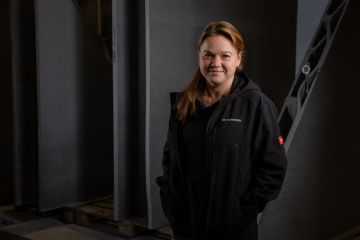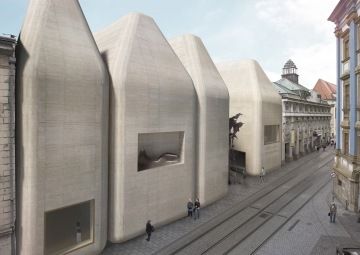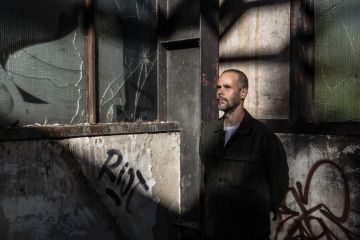
Serge Borenstein is the initiator of significant developments that have led to the successful transformation of exhausted brownfields in Prague. More than 25 years ago, he kick-started processes that are today considered the standard for quality urban development and draws upon his ability to recognize potential where others see none. The developer, who gave Karlin a new face, describes himself as an adventurer in his profession. Now, together with artist Federico Díaz, he is embarking on another challenge and believes that together they are opening a new chapter in the history of architecture.
Share article
How did you meet Federico?
It‘s a long story of a relationship between an artist and a businessman that began about twenty years ago. Federico is very close to me as an artist but also as a person; he has my admiration. He has always had a passion for discovering and realizing the impossible.
Just like you...
Yes, that‘s probably what brought us together.
What convinced a businessman to start a company with an artist focused on using digital concrete in architecture?
One day, Federico introduced me to the process he uses to create a gigantic sculpture. It involved robotic production using a special concrete mixture called UHPC. We talked about the incredible possibilities this technology offers contemporary architecture compared to traditional construction processes. Thus, the idea to start a company was born “over coffee.” I believe our product is revolutionary because you can design and produce practically anything. With that, we decided to approach architects. Imagine, for instance, columns that twist, turn, and bend—something impossible through traditional means. I see this as the beginning of a great adventure.
Does Federico Díaz’s personality bring something unique to So Concrete compared to other technology companies?
From my perspective, absolutely. Federico is the father of So Concrete. He is constantly thinking about how to push the whole concept further. Of course, there are those who feel that an artist can’t bring anything substantial to construction. They don’t understand that this is about creativity. A creative mind. Some people are simply afraid of “too much” creativity. Ideas can be dangerous, and they certainly are dangerous! They can disrupt the rules of our world.
Is it that simple? Someone comes to you with an idea, and you just make it happen?
Most of my ventures were decided on the spot. The story of So Concrete isn’t complicated either. Big things don’t have to be complex to be successful. Often, it‘s about being in the right place at the right time. Deciding on something and going for it. Believing.
In the construction industry, you must encounter doubts and distrust of new technologies...
Yes, especially when it comes to obtaining government approval for structural elements. In the Netherlands, for example, they build a small pedestrian bridge, and the authorities evaluate its stability over time. They will then issue permits for footbridges. The Netherlands is a pioneer in this, which will benefit other countries as well.
If the current legislation doesn’t allow for more complex structures, what is your current product?
In the meantime, as we wait for authorization for our technology for construction, we are focusing on architectural and building components that are not structural, such as façades, even for twenty to fifty-story buildings. Our technology allows us to create shapes that are impossible, or at least very complicated, if using conventional concrete.
"Some people are simply afraid of “too much” creativity. Ideas can be dangerous, and they certainly are dangerous! They can disrupt the rules of our world."
Where do you personally find the confidence that your business decisions are going in the right direction? Specifically, 25 years ago in Karlín?
One explanation is that I am not an analyst. All my major decisions are based on feelings. As I gain more experience with age, whenever I get the feeling of creating a new product, I naturally seek the opinions of, let’s say, more analytical people, and so both aspects come together. However, it always starts with a personal feeling. That was the case in Karlín as well. I felt that one day people would love to live close to the city center in a place where they can work and also enjoy their free time. I wasn’t the only one in the world who believed that one could work and live in the same place, but most people were under the impression that an office had to be somewhere, and a home elsewhere. So, I started something entirely new... and it worked. Other developers followed this way of thinking.
How would you characterize yourself as a developer?
As an adventurous developer, who with age, has also gained some wisdom.
You have more than a quarter-century of experience in construction in the Czech Republic. Do you observe any local specifics?
I can tell you one thing. I am amazed at how local people are engaged in the development of their city. Such interest in the environment and in how the city evolves, I have not experienced in Belgium or France. It’s much easier to work when people appreciate what you do. You see that you are creating for people, and they are grateful for it. Or not... if you don’t succeed. However, I must also state that the construction process is unfortunately under heavy political pressure, which is a problem that costs us a lot of time. This particularly concerns the decision-making for the city of Prague.
You are currently starting developments outside of Prague, in the forests of Ralsko. In the Jabloneček Valley, So Concrete is designing several structures and installations in collaboration with architects and artists. How do you feel being your own client?
I am completely content, precisely because I am on both sides. With So Concrete technology, I might prefer to create an entirely new building in the city center, but I am very proud of being able to integrate our material with nature in a much more enjoyable way than just seeing four straight walls built in the forest. Concrete can also be mixed with natural materials and creatively played with in terms of form. The architects we collaborate with are fascinated by the possibility of working with our product.
Will Jabloneček be the showroom for So Concrete?
Jabloneček is more of a personal project, and if it ever becomes a showcase for this new technology, it certainly won’t be out of necessity. The idea for Jabloneček originated long before I became interested in UHPC and robotic fabrication. It took years before I decided on the direction we would take with the development of Jabloneček. After COVID, I realized it was actually more about returning to the people living here, to their land. I decided to create a new type of condominium in the middle of the forest, offering a product in nature. When I started building So Concrete with Federico, I thought, why not take advantage of this opportunity? Otherwise, we would probably work with traditional technologies. But I am not always necessarily guided by simplicity. I respect it, but I love challenges. And believing in a new product is truly a challenge.
Are you using your products in the portfolio of Karlín Group projects in Prague?
Yes, we are currently developing several projects in the urban area where we will be using our products for facade elements and balconies.


According to So Concrete’s motto, dreams are concretized here. What is your dream?
In general, I would like to improve the quality of the buildings we see in the city. The creativity of past centuries was replaced by pragmatism in 20th-century architecture. I believe that our product combines creativity and pragmatism, offering architects many more possibilities than just constructing walls for buildings that look similar to one another.
So far, you have chosen excellent studios for your projects, many of which have grown along with your developments. Do you enjoy supporting new studios in the development scene?
I care about the personality of the architect, but mainly about what they do and how they think. I strive to prioritize originality and, of course, efficiency. You might point out that our first buildings were created with world-renowned architects like Ricardo Bofill. That is certainly true, but for many years we have been trying to collaborate more with young local studios, seeking new approaches from them rather than specifically from foreign architects. In the beginning, we relied on the perspective and experience of foreign studios, and today we still collaborate with some but often in cooperation with a Czech studio.
So Concrete is currently focusing on production that doesn’t require structural tests. You are experimenting and developing. Where do you see the company in the coming years?
I don’t claim that we are the only ones; there are already several companies in Europe printing concrete. I firmly believe that robotic fabrication is the future for a large part of construction. It addresses labor shortages and allows for greater precision. At the same time, it offers enormous design variability. Today, many architects are still unaware of the various possibilities, for example, in façade design. But that will soon change. We anticipate great success with the use of this technology.
What does digital concrete technology offer architects?
Flexibility. Flexibility. Flexibility. Creating an interesting, organic, dynamic façade today is quite difficult. Everything is prefabricated, flat. This new technology allows us to make buildings much more vibrant. It truly opens a new chapter in the history of architecture.
Are architects already interested in the technology?
Their interest is slowly emerging. Architects are exploring new possibilities for designing and building. The situation is similar in other European countries; the Dutch and some Austrian companies are more or less at the same level as us.
New possibilities are opening up for architects, but are investors also interested in the technology?
The construction company decides on the technology. If they want to use robots, they propose such a solution to the investor. However, most companies still want to stick to the traditional way. A few young companies are willing to start with robots. We are currently in talks with three such companies that are seriously interested in the technology. However, it seems our next task is to initiate the creation of a construction company that will apply these new possibilities.
"With So Concrete technology, I might prefer to create an entirely new building in the city center, but I am very proud of being able to integrate our material with nature in a much more enjoyable way than just seeing four straight walls built in the forest."
Are large construction companies not interested in the technology?
They are interested, but they are cautious. Large corporations and companies, which I use for projects in the Karlín Group, are just beginning to test the technology. It is much more challenging for them to move in this direction because the level of investment is very different for them.
How many years will it take for the technology to become established in the construction industry?
We’re talking about two to three years for companies to get used to the idea of using the technology, and three to five years before they start applying it. You have to build a large structure to prove that it works. This also applies to facades, and even more so for structural façades, which will take more than five years. People need to see that new technology works. It’s like with electric cars or hydrogen-powered cars. We are now preparing to create the façade of a large building, which will serve as our proof.
Are you focusing on the local scene or aiming to operate globally?
We definitely want to operate internationally; the world isn’t too big! Our CEO is currently very active, especially in Spain, working with various architects who have projects all over the world. There are big fans of digital concrete in Saudi Arabia. We are also negotiating to cooperate with Ricardo Bofill’s studio, and I believe we will soon announce some exciting news!
And what about Czech studios?
We collaborate with several very interesting Czech studios, such as CHYBIK + KRISTOF, KOGAA, and Formafatal from the current young generation. They are following the developments at So Concrete and I believe they will use our technology for other clients as well.
Share article
More news
Marie Kovářová, CEO of So Concrete
"Everything is possible when there’s a will. And a good team can achieve much more than any individual," says Marie Kovářová, the new CEO of So Concrete.
A Chance for SEFO
Jan Šépka is one of the most daring architects in the Central European scene. His projects are designed with uncompromising honesty, and push the oundaries of the conventional to the unimaginable.
Unseen Worlds
Federico Díaz is a unique artist, technological innovator, and remarkable thinker whose contemplation of the world will resonate with you long after speaking with him. Díaz’s artistic creation lies at the intersection of cutting-edge technology, respect for natural laws, historical development, and represents a crucial building block of the So Concrete project, pushing the boundaries of robotic fabrication. What does concrete mean to him, and what role does he see for artificial intelligence?


